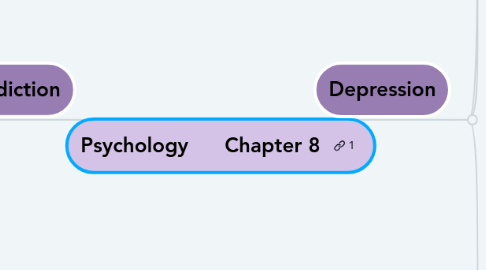
1. Addiction
1.1. What is it ?
1.1.1. Chrarcteristics
1.1.1.1. Salience
1.1.1.1.1. The substance/activity becomes the most important thing in a persons life
1.1.1.2. Dependance
1.1.1.3. Substance absuse
1.1.2. Dependence vs addiction
1.1.2.1. Dependence is doing something because of psychological need and to prevent withdrawal symptoms
1.1.2.2. Addiction is being dependent on the substance/activity but doing it for the buzz and sense of escape
1.1.3. Sunstance misuse vs abuse
1.1.3.1. Misuse is not following the rules of usage like taking a substance more than recommended
1.1.3.2. Abuse is using the substance as a way to get high or to escape a situation
1.1.4. Diagnosing addiction
1.1.4.1. A strong desire to use the substance
1.1.4.2. Persisting despite the known harm
1.1.4.3. Difficulty in controlling use
1.1.4.4. A high priory given to the substance/activity
1.1.4.5. withdrawal symptoms if substance is stopped being taken
1.1.4.6. High tolerance e.g. needing more to have the same effect
2. Depression
2.1. Types of depression
2.1.1. Symptoms
2.1.1.1. Low mood
2.1.1.1.1. Depressed mood most of the day
2.1.1.2. Lost of interest and pleasure
2.1.1.2.1. Diminished interest of the activities of the day
2.1.1.3. Reduced energy levels
2.1.1.3.1. This has a knock on effect for family, education and work
2.1.2. Bipolar depression
2.1.2.1. Changes between two mood states
2.1.2.1.1. Depression and mania
2.1.2.1.2. Mania is state of euphoria
2.1.3. Unipolar
2.1.3.1. Th person only feels one emotional state
2.1.3.1.1. Depression
2.2. Theories of depression
2.2.1. Biological
2.2.1.1. Imbalance of neurotransmitters
2.2.1.1.1. Messages travel along a neuron electrically but the message is transmitted chemically through a synapse
2.2.1.2. Serotonin
2.2.1.2.1. High levels of serotonin in the synaptic cleft means the postsynaptic neuron is being stimulated
2.2.1.2.2. Low levels at the synapse means ledd stimulation pf the postsynaptic neuron
2.2.1.3. Evaluation
2.2.1.3.1. One advantage is there is supporting research, lower levels of serotonin where found with people with depression suggesting there is a link between low levels of serotonin and depression
2.2.1.3.2. One weakness id that low levels of serotonin could be an effect of being depressed, thinking sad thoughts could cause low serotonin levels suggesting its an effect rather than acause
2.2.2. Psychological
2.2.2.1. Faulty thinking
2.2.2.1.1. Thinking is not logical and think negatively rather than positively
2.2.2.2. Negative schemas
2.2.2.2.1. Schemas are mental frameworks containing ideas and information developed through experience
2.2.2.2.2. Having a negative self-schema means you will interpret everything in a bad way
2.2.2.3. Attributions
2.2.2.3.1. Explaining causes of behaviour
2.2.2.3.2. Internal, global and stable attributions
2.2.2.4. The influence of nurture
2.2.2.4.1. 'learned helplesness'
2.2.2.5. Evaluation
2.2.2.5.1. There is research support for learned helplessness, dogs reacts to challenge by 'giving up'. Therefore this supports his explanation of depression due to negative attributions
2.2.2.5.2. A weakness is that negative beliefs may be realistic rather than depressing, depressed people gave more accurate estimates to a likelihood of a disaster than 'normal' people. Therefore a negative attribution style may not be all bad.
2.3. Therapies of depression
2.3.1. Antidepressant medication
2.3.1.1. SSRI
2.3.1.1.1. Selectively targets serotonin at the synapse
2.3.1.1.2. Inhibits the reuptake of the serotonin molecules
2.3.1.2. Presynaptic neuron
2.3.1.2.1. Serotonin is released by certain neurons in the brain. It is stored in tiny sacs called vesicles, the electrically signal travelling through the neuron causes the vesicles to release the neurotransmitter into the synaptic cleft.
2.3.1.3. Evaluation
2.3.1.3.1. SSRIs can have serious side effects, insomnia, weight loss, dizziness and even suicidal thoughts. People stop taking the drug, affecting the effectiveness of the drug therapies.
2.3.1.3.2. Another weakness is that effectiveness is questioned, possibly the amount of placebo in depressed person is the same in someone normal, questioning whether it may be a placebo effect.
2.3.2. CBT
2.3.2.1. Cognitive
2.3.2.1.1. Focuses on what the client is thinking
2.3.2.2. Behaviour
2.3.2.2.1. Change behavior indirectly through changing thinking
2.3.2.3. Therapist dealing with the 'irrational thoughts'
2.3.2.3.1. 'disputing' is used to deal with the irrational thoughts. The irrational thoughts are challenged and more rational thinking leads to better self-belief
2.3.2.4. Thought diary
2.3.2.4.1. The client writes down there irrational thoughts in a 'thought diary'and rates how much they believe in these thoughts.
2.3.2.5. Evaluation
2.3.2.5.1. It has lasting effectiveness, the tools used in CBT can be used in future depression for the client. Therefore the therapy can be used as a long-term solution
2.3.2.5.2. A weakness is it takes a long-term to be successful, it takes months and a lot of effect is needed compared to just taking a pill. meaning may drop out or wont enough effort in it to work.
2.3.3. Wile's study
2.3.3.1. Only 30% of patients who take antidepressants respond fully to them. The rest are 'treatment resistant' and need an alternative therapy instead.
2.3.3.2. Aim
2.3.3.2.1. Wiles set up the CoBaIT trail to further investigate the holistic approach.for treating people with 'treatment resistant' depression', compared to antidepressants alone.
2.3.3.3. Method
2.3.3.3.1. 469 patients were randomly assigned to either two groups; usual care (just antidepressants) usual care and CBT. the improvement was assessed before and after,
2.3.3.4. Results
2.3.3.4.1. After six months, 22% od usual care groups and 46% od usual care + CBT had more than 50% reduction in symptoms. after 12 months symptoms improved even more
2.3.3.5. Conclusion
2.3.3.5.1. In conclusion, CBT plus medication is better than medications alone.

